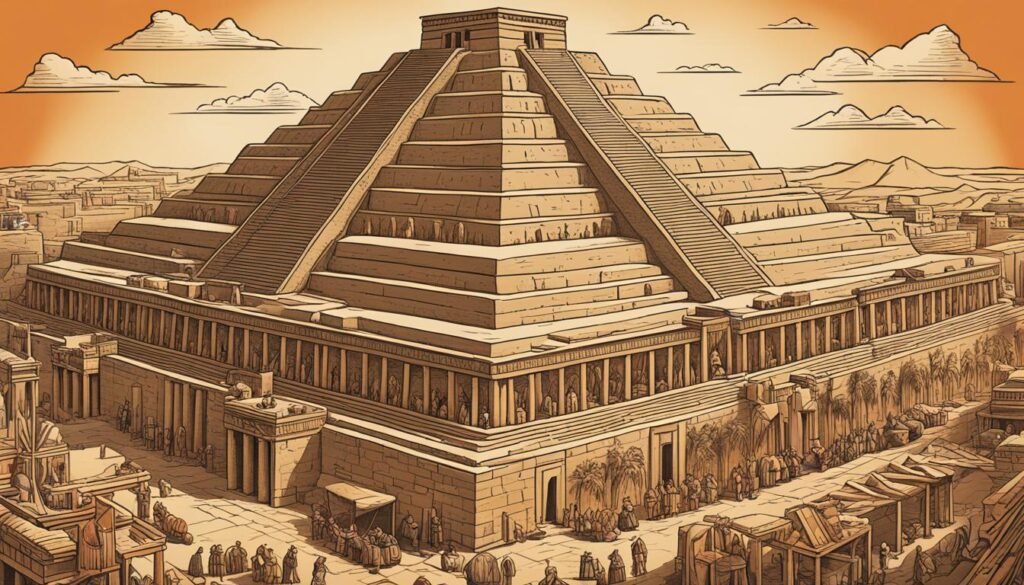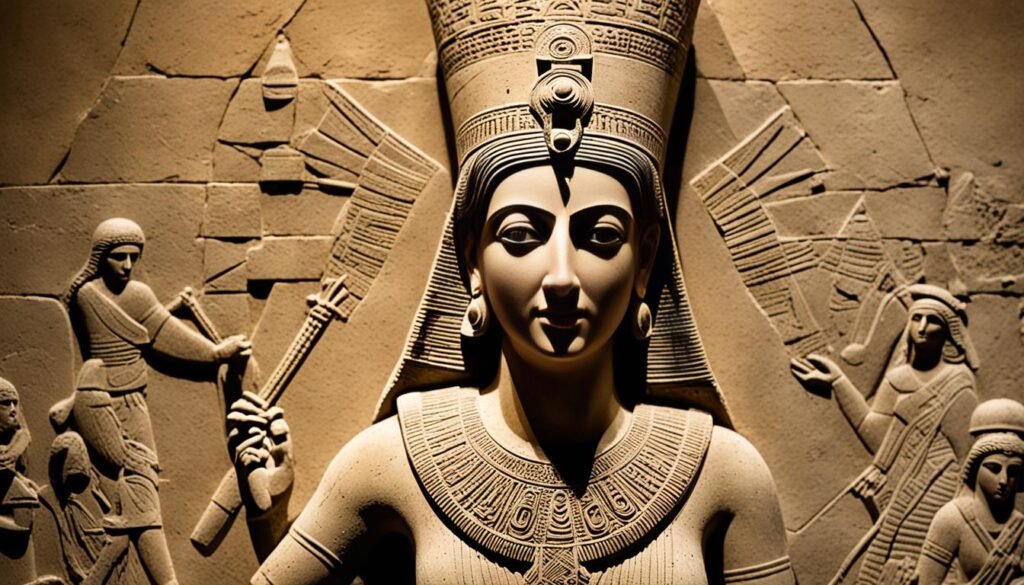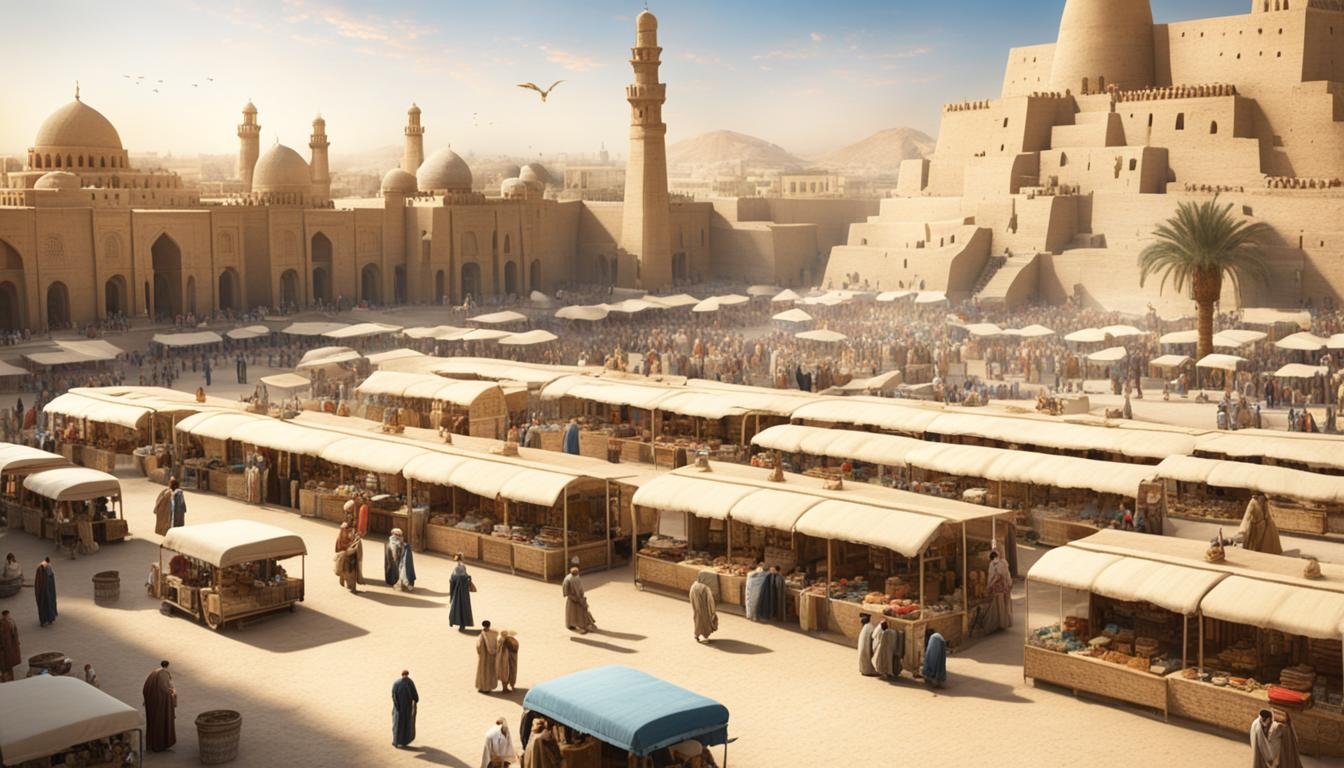The ancient ruins of Mesopotamia, the cradle of civilization, have captivated the world for centuries. In Iraq, the heartland of this legendary region, lay countless archaeological treasures that bear witness to the dawn of human urbanization and the rise of empires. With over 12,000 known archaeological sites, Iraq boasts a staggering wealth of historical artifacts, from cuneiform tablets to majestic Ziggurat structures, all waiting to be explored and preserved for future generations.
Key Takeaways
- Iraq is home to the birthplace of Mesopotamian civilization, with over 12,000 known archaeological sites.
- The region between the Tigris and Euphrates rivers, known as the Fertile Crescent, gave rise to the first complex urban centers in human history.
- Iraq’s archaeological heritage includes cuneiform tablets, Ziggurat structures, and the remnants of ancient empires like the Babylonians and Assyrians.
- Despite decades of conflict, Iraq is now experiencing a resurgence of interest in its rich cultural legacy, with efforts to preserve and protect its archaeological treasures.
- The exploration of Iraq’s Mesopotamian sites offers a glimpse into the origins of human civilization and the development of early urban societies.
The Cradle of Civilization: Mesopotamia’s Ancient Ruins
Iraq is a land steeped in history, home to the remarkable Mesopotamian civilization that gave rise to some of the earliest urban centers in human history. This region, often referred to as the “Cradle of Civilization,” is a treasure trove of archaeological wonders that offer a glimpse into the remarkable achievements of the Sumerian, Babylonian, and Assyrian cultures that flourished along the banks of the Euphrates River.
Mesopotamia: The Birthplace of Urban Centers
The Mesopotamian civilization, which emerged in the Fertile Crescent between the Tigris and Euphrates rivers, is renowned for its pioneering advancements in architecture, agriculture, and early forms of writing, such as the cuneiform tablets. The iconic Ziggurat structures, like the renowned Ziggurat of Ur, stand as testaments to the engineering prowess of the Mesopotamian people, who built these stepped pyramids as platforms for their temples and religious rituals.
Iraq’s Archeological Treasures: A Testament to Human History
From the ancient city of Babylon, with its legendary Hanging Gardens, to the mighty Assyrian capital of Nineveh, Iraq is home to a wealth of archaeological sites that continue to captivate historians and visitors alike. These ruins, scattered across the Mesopotamian landscape, offer a glimpse into the rich cultural heritage and technological advancements of the Mesopotamian civilization, which laid the foundation for many of the modern world’s greatest achievements.
Explore the Legendary Sites of Ancient Mesopotamia
Mesopotamia, the cradle of civilization, boasts a rich tapestry of ancient wonders that continue to captivate historians and archaeologists alike. Among these legendary sites are the iconic Babylon and the mighty Assyrian capital of Nineveh, both of which offer a glimpse into the grandeur and ingenuity of the ancient Mesopotamian world.
Babylon: Home to the Hanging Gardens
Babylon, located approximately 85 kilometers south of modern-day Baghdad, was the capital of the Babylonian Empire and a true marvel of the ancient world. The city’s most famous landmark, the Hanging Gardens of Babylon, was one of the Seven Wonders of the Ancient World, a testament to the engineering prowess of the Babylonians. Visitors can explore the ruins of this once-thriving metropolis and imagine the verdant, terraced gardens that were said to have adorned the city.
Nineveh: The Mighty Assyrian Capital
Situated near the city of Mosul, the ancient city of Nineveh was the capital of the Assyrian Empire, one of the most powerful civilizations in Mesopotamian history. The ruins of Nineveh, including the palace of King Sennacherib, the city walls, and the grand gates, offer a glimpse into the might and grandeur of the Assyrian Empire. Archaeologists continue to uncover new treasures and insights into this important Mesopotamian center of power.

Iraq: Mesopotamian archaeology Baghdad Iraq
Venture into the heart of Mesopotamian archaeology in Baghdad, Iraq, and uncover the captivating legacy of the ancient Sumerian civilization. At the forefront of this extraordinary journey lies the city of Ur, a remarkable relic of the past that continues to captivate historians and visitors alike.
Ur: The Great Ziggurat and Sumerian Legacy
Situated near the city of Nasiriyah, Ur stands as a testament to the ingenuity and architectural prowess of the Sumerians. The most striking feature of this ancient site is the imposing Great Ziggurat of Ur, a towering stepped pyramid that was once dedicated to the moon god Nanna. Explore the ruins of this grand structure and delve into the Sumerian civilization that thrived in the Mesopotamian region thousands of years ago.
The excavations at Ur have provided invaluable insights into the development of early urban centers in Mesopotamia, shedding light on the Sumerian legacy that laid the foundations for subsequent civilizations. By immersing yourself in the Mesopotamian archaeology of Baghdad, you can uncover the rich tapestry of human history that has unfolded in this remarkable region.
Discovering Iraq’s Ancient Wonders
Amidst the vast deserts of northern Iraq, a forgotten oasis of ancient splendor emerges – Hatra, a city that once thrived as a center of culture and commerce during the Parthian Empire. This archaeological site, dating back to the 1st and 2nd centuries CE, offers a captivating glimpse into Mesopotamian archaeology, revealing the resilience and ingenuity of the region’s past inhabitants.
Hatra: A Forgotten Desert Oasis
The ruins of Hatra, a UNESCO World Heritage site, stand as a testament to the remarkable engineering and architectural prowess of the Parthian civilization. The city’s massive walls, intricate temples, and grand palaces showcase the wealth and sophistication of this ancient oasis, which served as a vital hub along the Silk Road trade routes. Visitors to Hatra can explore the remnants of this forgotten desert metropolis, marveling at the intricate carvings, sculptures, and inscriptions that have withstood the ravages of time.

The archaeological significance of Hatra extends far beyond its physical structures. The site has yielded a wealth of information about the cultural and religious practices of the Parthian Empire, which once dominated the region. Scholars continue to study the artifacts and inscriptions found at Hatra, unlocking the secrets of this ancient civilization and its influence on the broader Mesopotamian landscape.
Treasures of the Fertile Crescent
Nestled within the heart of the Fertile Crescent, the ancient city of Ctesiphon stands as a testament to the architectural and cultural achievements of the Parthian Empire. This monumental relic, located on the eastern bank of the Tigris River just 35 kilometers southeast of Baghdad, serves as a captivating gateway into the rich Mesopotamian archaeology that has shaped the region.
Ctesiphon: The Monumental Arch of Parthian Splendor
The ruins of Ctesiphon, once the capital of the mighty Parthian and Sassanid Empires, are dominated by the colossal arch known as the Taq-i Kisra, or the Arch of Ctesiphon. This stunning brick structure, measuring over 100 feet in height, is considered one of the largest single-span brick arches in the world, showcasing the engineering prowess of the Parthian people. The grandeur of this ancient monument is a testament to the cultural and architectural achievements that flourished within the Fertile Crescent during the Parthian era.
Exploring the Ctesiphon site offers a unique opportunity to delve into the rich tapestry of Mesopotamian archaeology, unraveling the captivating history of the Parthian Empire and its lasting impact on the region. This remarkable archaeological treasure, nestled within the Fertile Crescent, continues to captivate and inspire scholars and visitors alike, promising a deeper understanding of the enduring legacy of the ancient civilizations that once thrived in this culturally significant area.
Uncovering the Assyrian Empire
The archaeological sites in Iraq offer captivating insights into the rich history of the Assyrian Empire, which was one of the dominant powers in the region during its heyday. The ruins of ancient Assyrian cities, such as Nimrud and Ashur, provide invaluable information about the political, cultural, and artistic achievements of this remarkable civilization.
The Assyrian Empire, which flourished from the 9th to the 7th century BCE, was renowned for its military prowess, administrative sophistication, and architectural grandeur. Excavations at these sites have unearthed an array of artifacts, including cuneiform tablets, sculptures, and palace complexes, that shed light on the Assyrians’ advanced bureaucracy, expansionist policies, and cultural sophistication.

Through the lens of Mesopotamian archaeology, researchers have been able to piece together the intricate history of the Assyrian Empire, tracing its rise to power, its interactions with neighboring civilizations, and its eventual decline. These archaeological treasures not only captivate visitors but also serve as a testament to the enduring legacy of the Assyrian people and their profound impact on the ancient world.
By exploring the ruins of the Assyrian Empire, we gain a deeper understanding of the rich tapestry of Mesopotamian history and the pivotal role that this ancient civilization played in shaping the cultural and political landscape of the region. The Assyrian sites in Iraq continue to fascinate and inspire scholars, archaeologists, and history enthusiasts alike, offering a window into the past that illuminates the enduring significance of Mesopotamian archaeology.
Ashur: The Eternal City of Assyria
Nestled on the banks of the Tigris River, approximately 60 kilometers south of Mosul, lies the ancient Assyrian city of Ashur. This historic site, once the capital of the mighty Assyrian Empire, stands as a testament to the grandeur and significance of Mesopotamian archaeology. The ruins of Ashur, including the temple of Ashur, the city walls, and the intricate gates, offer a captivating glimpse into the past, showcasing the architectural and cultural achievements of this ancient civilization.
However, the preservation of Iraq’s cultural heritage remains a significant challenge, particularly in the aftermath of the ISIS occupation. The damage inflicted on several archaeological sites, including Ashur, has highlighted the urgent need to safeguard these invaluable treasures for future generations. The preservation of Ashur and other Mesopotamian archaeological sites is crucial not only for understanding our shared human history but also for honoring the legacy of the Assyrian Empire and the rich cultural heritage of Iraq.
Preserving Iraq’s Cultural Heritage
Across Iraq, concerted efforts are underway to protect and restore the country’s cultural heritage. Archaeologists, historians, and government officials are working tirelessly to secure and preserve the remnants of the Assyrian Empire, including the site of Ashur. These initiatives not only safeguard the physical structures but also aim to revive the collective memory and identity of the Iraqi people, who have endured the erosion of their cultural heritage due to conflict and instability.
The preservation of Ashur and other Mesopotamian archaeological sites is crucial not only for understanding our shared human history but also for honoring the legacy of the Assyrian Empire and the rich cultural heritage of Iraq. As we continue to uncover the secrets of this ancient civilization, the world must remain vigilant in its commitment to safeguarding Iraq’s invaluable cultural treasures for generations to come.
The Looting Crisis: Protecting Iraq’s Antiquities
The aftermath of the U.S. invasion of Iraq in 2003 led to a devastating crisis of looting at the country’s archaeological sites and the National Museum of Iraq. Thousands of priceless artifacts, representing the rich cultural heritage of Mesopotamia, were stolen and lost forever. Among the stolen treasures was the iconic Lady of Warka, a Sumerian artifact dating back to 3100 B.C. and one of the earliest known representations of the human face.
The Lady of Warka: A Story of Resilience
The Lady of Warka, a captivating Sumerian artifact, has become a symbol of the ongoing efforts to protect Iraq’s cultural heritage. This ancient treasure, a testament to the artistic and technological accomplishments of Mesopotamian civilization, was eventually recovered by American and Iraqi investigators after being stolen from the National Museum of Iraq. The resilience of the Lady of Warka and the determination of those who worked to repatriate it highlight the critical importance of safeguarding Iraq’s invaluable Sumerian artifacts and cultural legacy.

The looting crisis in Iraq has underscored the urgent need to strengthen the protection of the country’s rich archaeological sites and museum collections. Efforts are underway to recover and repatriate the stolen artifacts, as well as to enhance security measures and international cooperation to prevent further loss of Iraq’s cultural heritage. The story of the Lady of Warka serves as a poignant reminder of the resilience and significance of Mesopotamia’s ancient treasures, and the ongoing battle to preserve them for future generations.
Efforts to Recover and Repatriate Iraq’s Stolen Artifacts
The widespread looting of Iraq’s archaeological sites and the National Museum of Iraq following the 2003 invasion has led to a significant loss of the country’s cultural heritage. Iraqi artifacts have been stolen and trafficked across the globe, posing a grave threat to Mesopotamian archaeology and the preservation of Iraq’s rich history.
In response, the U.S. government has made concerted efforts to recover and repatriate many of the stolen artifacts. The Immigration and Customs Enforcement (ICE) agency has returned more than 1,200 items to Iraq between 2008 and 2015, a testament to the ongoing battle against the illegal trade of Iraqi antiquities. However, it is estimated that around 8,000 artifacts are still missing, and the looting and illicit trafficking of these treasures continues to be a significant challenge in preserving Iraq’s cultural heritage.
The repatriation of these stolen Mesopotamian artifacts is crucial for Iraq’s efforts to reclaim and protect its ancient history. By recovering these looted artifacts, the international community can help Iraq rebuild its cultural identity and ensure that the legacy of the cradle of civilization is preserved for future generations to explore and appreciate.
Conclusion
The archaeological sites in Iraq offer a captivating window into the rich and remarkable history of the Mesopotamian civilization, widely regarded as the cradle of human civilization. From the ancient ruins of Babylon and Nineveh to the majestic ziggurats and monumental arches of Ctesiphon, these sites stand as a testament to the ingenuity, artistry, and cultural achievements of the Mesopotamian people.
Despite the challenges posed by decades of conflict and the ongoing threat of looting, the preservation and protection of Iraq’s archaeological treasures remain crucial to our understanding of our shared human history and heritage. The Mesopotamian archaeology in Baghdad, Iraq, holds the potential to uncover groundbreaking insights into the origins and development of urbanization, writing, and other pivotal advancements that have shaped the course of human civilization.
As we continue to explore and study these ancient wonders, we are not only honoring the legacy of the Mesopotamian civilization but also safeguarding the cultural heritage of Iraq for future generations. The significance of Mesopotamian archaeology, the preservation of Iraq’s cultural heritage, and the importance of archaeological preservation cannot be overstated, for they are essential in deepening our understanding of the Mesopotamian civilization and its enduring impact on the world.
Source Links
- It’s Disturbingly Easy to Buy Iraq’s Archeological Treasures – https://www.theatlantic.com/international/archive/2018/03/iraq-war-archeology-invasion/555200/
- Ancient Babylonian and Mesopotamian Archeological Sites You Can Visit in Iraq — Inertia Network – https://www.inertianetwork.com/magazine/ancient-babylonian-and-mesopotamian-archeological-sites-you-can-visit-in-iraq
- Archive of Mesopotamian Archaeological Reports (AMAR) – https://repo.library.stonybrook.edu/xmlui/handle/11401/88604
